Caves are often covered with mold, they are dirty and raw. They can also be as wide as a canyon, can swell with life or be flooded with icy water. They can consist of marble, crystals or basalt. Caves are much more than just holes in the ground. Some of them are rather unusual caves in the world.
[specialads]
10. Cave Aisriesenwelt Cave
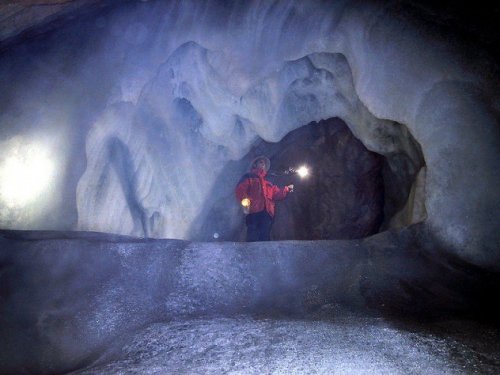
Cave Aisrisenvelt, located in Austria, is the largest ice cave in the world. Its length reaches about fifty kilometers. The name of the cave is translated as “The World of Ice Giants”. Cave Aisrisenvelt was discovered in 1879. The myriad cave compartments are interconnected, allowing air to circulate freely through each of them. It also means that the caves can be very cold, so winter clothing is suitable for visiting the cave at any time. Here you can see ice formations of different colors because of their different mineral content.
The cave is located above the village of Werfen Village in Salzburg. Before the beginning of the tour, all tourists are given out lamps and sometimes ice formations, glowing due to the magnetism of the lamps are truly a terrific sight. To be visited by the public, only a part of the cave is open.
9. Fingal’s Cave
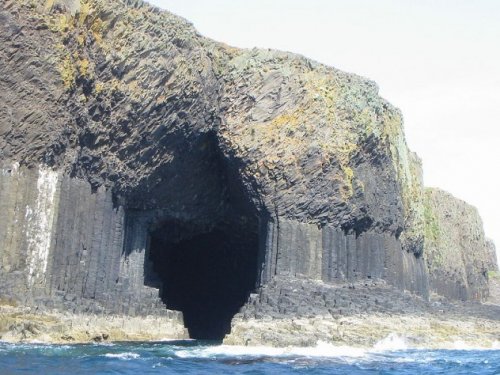
A famous sea cave washed in the rock by sea water, on the island of Staffa, is a part of the group of Inner Hebrides. The walls are made up of vertical hexagonal basalt columns with a depth of 69 meters and a height of 20 meters. It is a part of the Scottish reserve of the same name. In the Gaelic language, the cave is called Uamh-Binn, which can be translated as a “cave of melodies”. Indeed, thanks to a curved dome-like vault, this place has the unique acoustics. The whimsically transformed sounds of the surf are given throughout the interior of the cave, which gives it a resemblance to a gigantic, miraculous cathedral. The discoverer of the cave was the naturalist Joseph Banks, who visited these places in 1772. Because of the glory of this miracle of nature, the island was visited by Walter Scott, William Wordsworth, John Keats, Alfred Tennyson, Jules Verne, August Strindberg (the cave is the site of one of his works), Queen Victoria and artist Joseph Turner, who painted in 1832 a landscape Overlooking the cave.
8. Blue Grotto
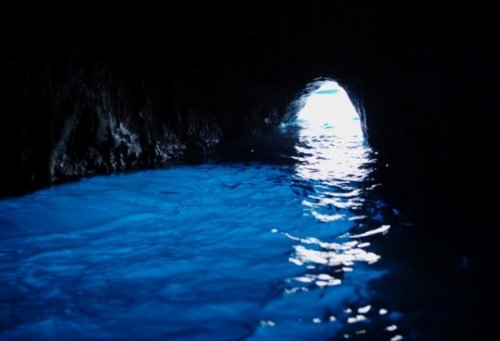
Grotto is situated on the northern shore of the island of Capri (Italy). The length of the grotto is 56 meters, width is 30, the height of the arch above the water level is 15 meters, the height of the entrance is up to 1.3 meters. At the grotto the only entrance is from the sea, and you can get into it only by boat. Due to low entry in stormy weather, the entrance to the grotto is not available. The bottom is flooded by the sea so that light penetrating the grotto gives the water and the entire cave a beautiful azure color. The beauty of the grotto was described by the German poet and painter August Kopish, after which the grotto became one of the most popular tourist attractions in Capri, and actually the emblem of the island. The grotto was known to the Romans, as evidenced by the Roman statues found in it.
7. Wisteria Tunnel
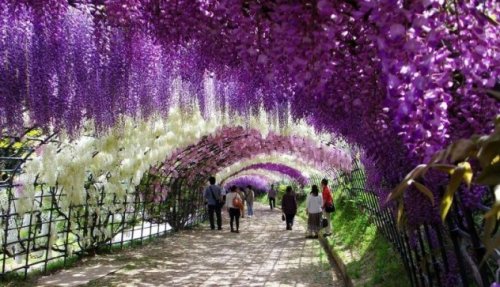
In the Kawachi Fuji Gardens, you can admire the striking variety of wisteria, that is located in the form of a tunnel. In the garden about 150 wisteria bushes grow, at least 20 different species, each of which pleases the eye with purple, white, blue, violet-blue, or pink. The best time to visit the gardens is the end of April – mid-May, when “Fuji Matsuri” or “Wisteria Festival” is held. The peak of the season falls at the end of April. Any visit outside of this time frame will mean that wisteria is not in bloom, and most of them are “a disappointing mass of lifeless branches,” according to Atlas Obscura.
6. The Cave of the Horde
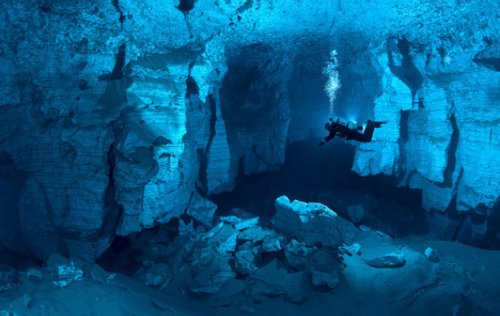
Ordinskaya cave is the longest underwater cave in Russia, and the only known in the world underwater gypsum cave. Its length is almost 5 kilometres. The water in the cave is so clean that scuba divers can see about 45 meters ahead. There are also no currents in the cave. The cave of the Horde is not the place where you would like to get lost. Scientists still find their small branches and grottoes, departing from the main cave. Any surface of the cave can easily break off when touched. In December 2012, a diver from Izhevsk, Vladimir Fedorov, set an extreme record in the Ordinsky cave, swam through the underwater gallery at a breathing delay of 100 meters.
5. Waitomo caves

Waitomo Caves are a homonymous village and the famous karst caves, which are the main attraction of the south of the Waikato area, on the North Island of New Zealand, 12 kilometres north-west of the town of Te Quiti. These Caves, as some scientists believe, are more than two million years old. Limestone formations surrounding the cave area have been a centre of tourism and speleology since 1900. Initially, improvised excursions were held in the caves, conducted by the local population. Then the Waitomo Caves were transferred to government supervision, and since 1904 they have become a permanent place of pilgrimage for tourists, the number of which has been increasing year by year. Waitomo caves are the habitat of crickets in New Zealand: Arachnocampa Luminosa. In the caves of Waitomo live thousands of crickets, which made these caves the main tourist attraction of the New Zealand island of North. In the Grotto of Crickets, you can get on a boat and swim under the lights of hundreds of crickets, seen on the water.
4. The underground river of Puerto Princesa (Puerto Princesa Subterranean River)

The Puerto Princesa Underground River located on the island of Palawan (Philippines), also known as the Underground River of St Paul, was given a status of the national park in 1971. It is an 8-kilometer river that flows directly into the sea. Along the way, it flows through the cave, winding along one of the most beautiful limestone formations in the world. Some of these formations resemble animals, mushrooms, and humans. In the area of its location, the National Park of the underground river of the city Puerto Princesa is established, a sanctuary located 50 km from the city. The park is located in the area of the St. Paul ridge in the northern part of the island. The city administration oversees the park. Before, it was also called the Underground River of St. Paul or the National Park of the underground St. Paul River. The entrance to the park is from the side of the city of Sabang. This river flows underground, in a cave, in the direction of the South China Sea. Its length is about 8 km.
3. Marble Cathedral (Marble Cathedral)

Marble Cathedral “Cuevas de Marmol” or the Marble Cathedral is a cave located in the Chilean lake of Buenos Aires, which is located on the border of Chile and Argentina. To get to the cave, tourists have to make a very difficult journey: they have to fly from the capital to the town located near the lake called Koyike, then drive 320 kilometres south of the lake. However, a long trip is worth it, and tourists admire the views of crystal clear waters and beautifully patterned walls of marble. You can get to the cave only by boat. This cave was formed 6,000 years ago due to the fact that the waves were beating on the calcium carbonate contained in the rock. The colour of the water varies depending on the weather conditions, the water level, and the time of the year.
2. Lubang Nasib Bagus

Lubang Nasib Bagus is a cave located on the island of Borneo, in Malaysia, Sarawak. The cave has the largest grotto in the world, known today in natural caves. It consists of a kilometre gallery leading to a very large cave hall. Lubang Nasib Bagus is famous for its grotto Sarawak – the largest cave grotto in the world. It is located in the Gunung Mulu National Park in Borneo. Its height is 100 meters, and the dimensions are 700 by 400 meters. The mainsail is so large that eight large jets can fit along its length, and it can also serve as a garage for 7,500 buses. All caves of the Cave were formed by running water about five million years ago. Among the other grottos of Lubang Nasib, you can distinguish the Cave of the Winds and the Grotto of Happiness.
1. The Cave of Krubera Crow (Krubera Cave/ unusual caves)

Cave Krubera -Voronya Krubera -Voronya – the deepest cave of the world (depth 2196 m), is located in the mountain massif Arabica in Abkhazia. The entrance to the cave is located at an altitude of about 2250 m above sea level in the Orto-Balagan tract. The karst cave of the sub-vertical type is a series of wells connected with each other by crossings and galleries. The deepest plumb lines are 115, 110, 152 m. Starting from a depth of 1300 m, the main branch leads to many other branches. In the bottom part, there are more than 8 syphons (located at depths from 1400 to 2144 m). The cave is located in the limestone layer, and the bottom part from the depth of 1600 m is laid in black limestones. The waters of the cave Krubera-Voronya are fed by the shortest river in the world – Reprua. The first woman to reach the depth of 2140 meters was Saule Pankene from Lithuania.
[postads]
Read also: 15 isolated places on the planet where you cannot go








